Recommended Best Products Individually Reviewed
1. Best £100-150/ Best Cheap Telescope: Sky-Watcher Heritage 100P
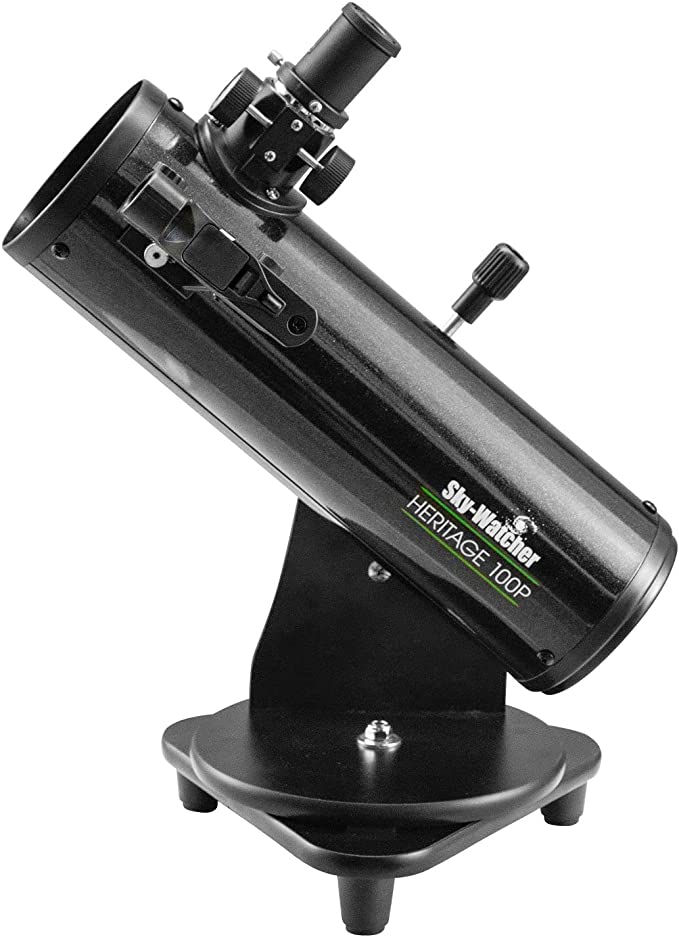
- Wide field of view
- High-quality 130mm primary mirror provides decent deep-sky and Solar System views
- Collapsible tube for portability
- Excellent accessories included
The Sky-Watcher Heritage 100P is a miniaturised tabletop Dobsonian telescope with 100mm of aperture. It features a parabolic primary mirror for sharp views, unlike many cheap reflectors which use spherical primary mirrors that can only provide fuzzy images in most cases. 100mm of aperture means that the 100P isn’t nearly as capable as the larger telescopes on our list, but it’s vastly superior to the cheap tripod-mounted reflectors and refractors often sold to beginners in its optical performance, light-collecting power, ease of use, and provided accessories. The 100P comes with two eyepieces and a 2x Barlow lens for 4 different magnification options, a red dot finder, and a tripod mounting bracket to attach to a sturdy third-party unit if you do not wish to set the scope on top of a table.
Alternatives
The Zhumell Z100 and Orion SkyScanner 100mm f/4 tabletop Dobsonians offer identical optics and performance to the 100P, but are not as well-equipped with accessories.
2. Best £200 Telescope / Best Portable Telescope: Sky-Watcher Heritage 130P
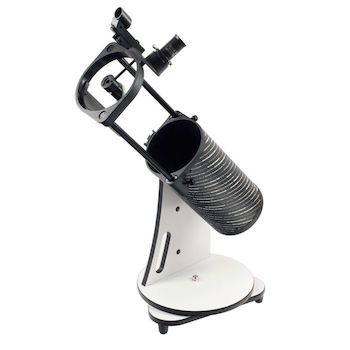
- Wide field of view
- High-quality 130mm primary mirror provides decent deep-sky and Solar System views
- Collapsible tube for portability
- Excellent accessories included
The Sky-Watcher Heritage 130P’s 130mm of aperture gives it much sharper and brighter views than the smaller 100mm and 114mm telescopes often marketed towards beginners, but without any additional bulk – it weighs just over 6 kg and will fit in a large backpack, passenger seat, or on a shelf when not in use.
With 130mm of aperture, you can start to see details in the brighter galaxies under dark skies, and watch shadow transits of Jupiter’s moons. You’ll also be able to begin resolving the brighter globular clusters into individual stars and see details on Mars when it is close to Earth.
The 130P comes with two eyepieces, 25mm and 10mm 3 3-element oculars providing 26x and 65x. As with most telescopes, you will probably want to expand your eyepiece collection particularly for higher magnifications on steady nights for viewing the Moon, planets, and close double stars. A collimation tool is also included for the sharpest possible views.
Alternatives
The Bresser Messier 5” Tabletop Dobsonian and Zhumell Z130 have the same optics as the Heritage 130P, but feature a bulkier solid tube design and different accessories are provided – though both are decent scopes.
3. Best £300 / Best 6” Telescope: Sky-Watcher Heritage 150P
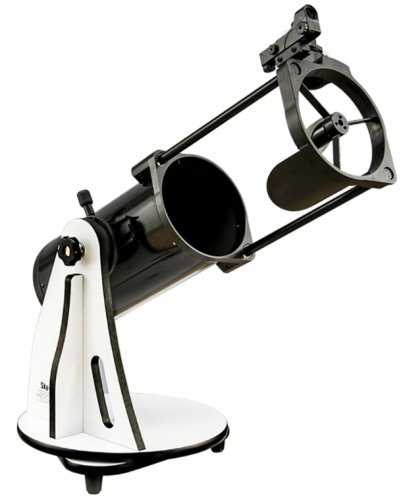
- Wide field of view
- 150mm aperture allows for serious viewing of deep-sky objects
- Collapsible tube for portability
- Wide field of view for its size
- Excellent accessories included
The Sky-Watcher Heritage 150P borrows a lot from the smaller 130P, having essentially the same features but with 20mm more aperture. That extra 20mm may not seem like much, but it makes a significant difference when it comes to viewing galaxies and globular star clusters.
As with the 130P, you get a collapsible tube, a pair of 25mm and 10mm eyepieces (30x and 75x respectively with the Heritage 150P), a red dot finder, and a simple tabletop Dobsonian mount. You will need to find a fairly steady surface to place this telescope on, however. Building a custom stand might not be a bad idea. A collimation tool is also included for the sharpest possible views.
Alternatives
The Bresser Messier 6” Tabletop Dobsonian offers similar performance to the 150P but with a 2” rack-and-pinion focuser and in a solid tube with rotating rings. However, it’s a bit heavier/bulkier and the provided eyepieces are not quite as good as what’s included with the Heritage 150P.
There are 6” f/8 full-sized Dobsonians available at the same price range as the 150P and Messier 6” Tabletop if you must have one. These include the Ursa Major 6” f/8 Planetary Dobsonian and Sky-Watcher Skyliner 150P Classic Dobsonian, which are easier to collimate and use at high magnifications on account of their longer focal ratio, as well as lacking the need for a table or stand. However, they are much bulkier, and their maximum field of view is more limited than a 6” f/5 tabletop Dobsonian.
4. Best £350-450/Budget 8” Telescope: Ursa Major 8” Dobsonian

- Large aperture but still easy to use
- Not much difference in storage space, setup or handling compared to a 6” f/8 Dobsonian
- Full-sized Dobsonian mount means no need for a table, stand, crate, etc.
- Decent provided accessory package
The Ursa Major 8″ Dobsonian is an economically-priced 8″ Dobsonian telescope, which encompasses many of the fundamental design features seen in more costly 8″ models, yet streamlined to the essentials. The Ursa Major 8″ Dobsonian delivers exceptional performance for its price, making it a desirable option for those on a budget.
The Ursa Major 8″ is not a tabletop scope, but rather rests on the ground independently, with a tube approximately 1.2 meters in length. The scope is undeniably less compact than a 6″ or smaller tabletop instrument, but you are rewarded with twice – yes, twice – the light-gathering ability, 33% more resolving power, and a robust, freestanding telescope that can endure a lifetime of use. The Ursa Major 8″ is also compatible with 2″ eyepieces, thanks to its 2″ diameter single-speed Crayford focuser.
Alternative
The Sky-Watcher Skyliner 200P Classic Dobsonian has the same basic features and accessory package as the Ursa Major 8”, but with a slightly inferior design for its Dobsonian mount and a lower quality but still decent 2” single-speed Crayford focuser.
5. Best £450-550/Best 8” Telescope: StellaLyra 8” f/6 Dobsonian

- Large 8″ aperture and easy collimation
- No significant portability difference from 6” f/8 Dobsonians
- No table, stand, or tripod needed
- Included accessories provide excellent value
- Extremely good value for the money
The StellaLyra 8″ f/6 is the most exceptional value 8″ Dobsonian you can acquire and comes with all the necessary accessories. It is one of our top selections for a telescope for nearly any task. The StellaLyra 8″ f/6 includes two eyepieces: a 2″ 30mm SuperView (40x) and a 1.25″ 9mm Plossl (133x). The StellaLyra 8″ f/6 is the finest 8″ Dobsonian available, alongside our top overall choice for a beginner telescope, and nothing surpasses the sheer value in its price range; some of the other 8″ Dobsonians from brands like Bresser or Sky-Watcher may cost marginally less, but just the dual-speed focuser is easily worth more than double the price increase of the StellaLyra 8″ f/6. The StellaLyra 8″ f/6 Dobsonian is the telescope we most frequently recommend to novices.
Alternative
The Celestron StarSense Explorer 8” Dobsonian does not come equipped with nearly as many accessories as the StellaLyra 8” Dobsonian or even the cheaper Ursa Major and Bresser 8” scopes, but has a lightweight Dobsonian base and features Celestron’s StarSense Explorer technology to help you locate deep-sky objects.
6. Best £550-750/Best 10” Telescope: StellaLyra 10” f/5 Dobsonian

- More performance than an 8” in essentially the same size package
- Excellent included features/accessories as with 8” model
- Still fairly portable
- Extremely good value for the money
The StellaLyra 10″ f/5 Dobsonian possesses the same features, accessories, focal length, and, naturally, excellent value for money as the 8″ variant; the only distinction is the slightly broader tube, and it offers you 56% more light-gathering prowess and 25% more resolution than an 8”. While it’s not much taller than the StellaLyra 8” Dobsonian, the mount is a little fatter and thus transporting it by car might be a little more difficult. It’s also a bit more challenging to collimate. But if you’re willing to accept these compromises, you’ll be rewarded with even brighter images than an 8” telescope and views that simply blow away a smaller instrument.
Alternatives
The Bresser Messier 10” Dobsonian actually has a superior designed mount to the StellaLyra, but its provided eyepiece and finder scope are extremely cheap while the price is actually higher. The Messier 10” also features a single-speed rather than a dual-speed 2” rack-and-pinion focuser, though it can easily be converted to a dual-speed unit in the future, and a solar filter is also included so you can view sunspots, as with the other telescopes in the Messier Dobsonian lineup.
7. Best £750-850, Best Computer-Assisted: Celestron StarSense Explorer 10” Dobsonian
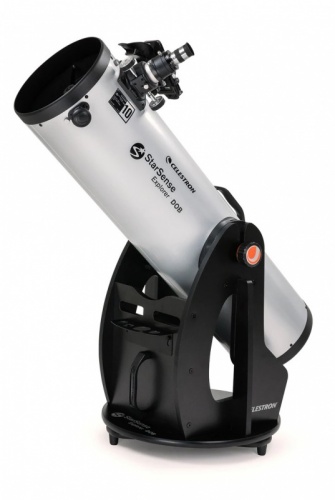
- 10” aperture packed with performance
- StarSense Explorer technology makes it easy to locate deep-sky objects
- Weight-optimized Dobsonian mount is more portable than the competition
The Celestron StarSense Explorer 10″ Dobsonian is a remarkably lightweight and portable option among 10″ Dobsonians. Its standout feature is the incorporation of Celestron’s StarSense Explorer technology that collaborates with your smartphone to make targeting deep-sky objects an effortless task. The provided accessories are not nearly as diverse as what comes with the 10” StellaLyra, but it’s easy enough to upgrade the StarSense Explorer 10” Dobsonian with more eyepieces and an aftermarket cooling fan if you want.
8. Best £850-1000/Budget 12” Dobsonian: StellaLyra 12” f/5 Dobsonian
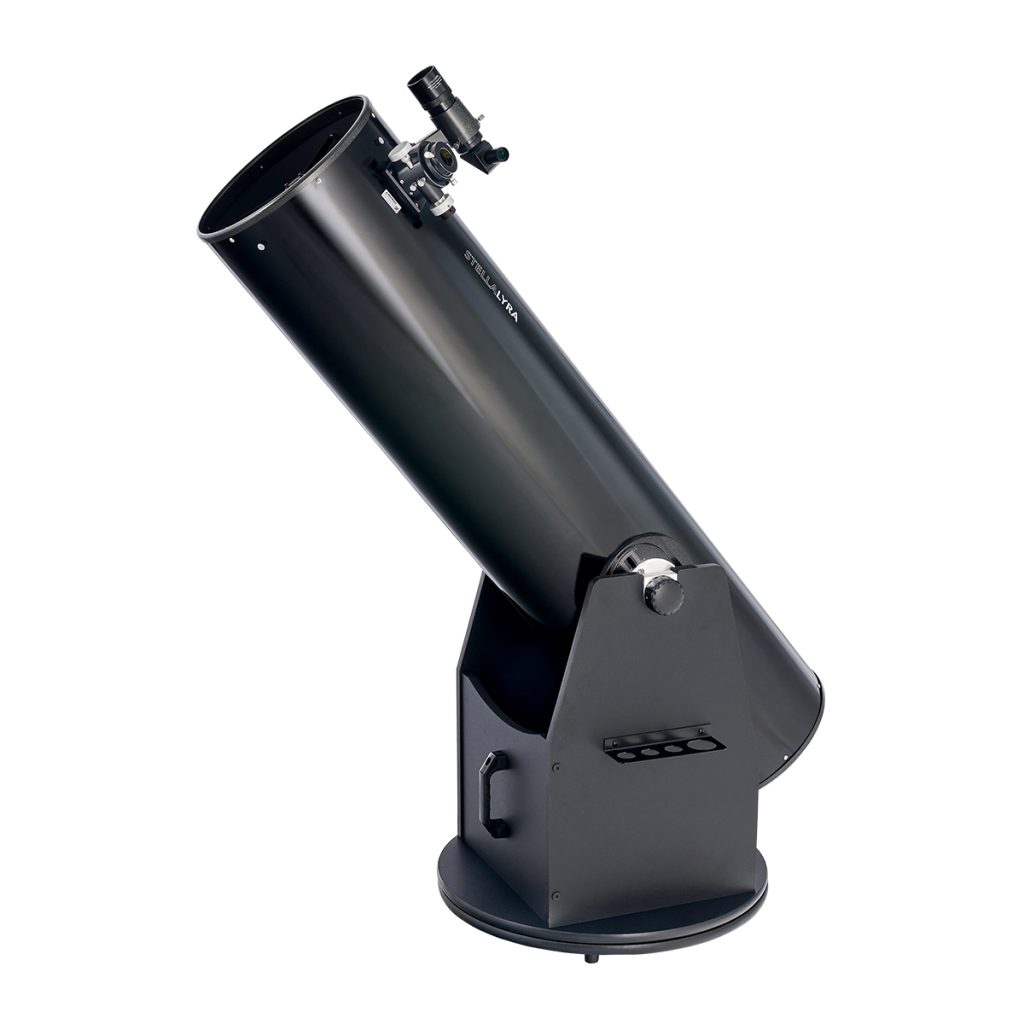
- Huge aperture
- Great accessories
- Simple to set up and use if you can accommodate its massive size
- Same features as smaller 10” and 8” StellaLyra models
The StellaLyra 12” f/5 Dobsonian is a 12” (304mm) Dobsonian with the same bearings and accessories as the 10” and 8” StellaLyra Dobsonians along with features like a dual-speed Crayford focuser and of course excellent optics. It’s even more capable than these and similar options on account of its huge aperture, providing fantastic deep-space as well as lunar and planetary views.
At around 35 kilos in total, the StellaLyra 12” is not a lightweight telescope. Its wide tube is rather awkward to carry too, but don’t fret! You make life easier with homemade or aftermarket straps to easily grapple the tube. Or just put the whole scope on a hand truck or dolly.
We’d recommend getting a smaller scope to complement the StellaLyra 12” f/5 Dobsonian, just to make sure you’re hooked before bringing this beast into your home. A smaller scope would help too, for nights when it isn’t worth hauling the big scope out. But if StellaLyra 12” f/5 Dobsonian is in your budget, and if you can get this scope to where you want it, do it. There’s nothing quite like the power of a 12 inch Dobsonian
9. Best £1000+, Best 12”: Sky-Watcher Skyliner 300P FlexTube

- Collapsible tube makes for a fairly portable instrument without the complex assembly of a truss
- Monster aperture will show fabulous deep-sky views and breathtaking planetary images
- Operation is no different from a smaller telescope
- Acceptable provided accessories
The Skyliner 300P isn’t for everyone. It’s a big telescope that requires a large vehicle to transport, and you’ll need to be in fairly good shape to easily lift and carry the 17kg base and 21kg tube around. However, the views through a telescope this size are amazing, especially if you’re fortunate enough to get it away from city lights. With 4 times the light gathering ability of a 6” telescope and 2 times the light gathering of an 8”, you’ll be able to view thousands of interesting targets under good conditions. A decent pair of eyepieces are provided to get you started, though you’ll be sure to want more.
The provided 9×50 right-angle finder makes aiming the 300P FlexTube a breeze, though you might want to add a Telrad or red dot sight to the mix. The 300P’s collapsible tube makes storing and transporting it a fair bit easier than it would be with a solid-tubed telescope this size, though you’ll really need to make or buy a cloth shroud to go over the middle to prevent stray light, bugs, moisture, and curious hands from getting into the tube during operation.
10. Best Budget Computerised Telescope: Sky-Watcher Virtuoso GTi 150P
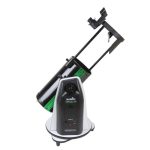
- 6” of aperture with fully motorized GoTo/tracking, all in an affordable and compact package for tabletop or tripod use
- Able to be used manually as well, even when powered on
- Smartphone/tablet app for mount rather than a hand controller makes for an easy-to-use system
- Otherwise same great features as Heritage 150P
The Sky-Watcher Virtuoso GTi 150P uses the same tube, optics, and tabletop Dobsonian mount as the Heritage 150P, but adds Sky-Watcher’s unique GTi GoTo system to the mix. The Virtuoso GTi mount can be used as a manual Dobsonian exactly like the standard Heritage 150P, or powered on for full automatic GoTo and motorized tracking controlled by your smartphone, with either the free SynScan app or another app like SkySafari. You can even aim the scope manually while the mount is powered on with no ill effects on the tracking or pointing accuracy of the motorized GoTo features. As with the Heritage 150P, you get two 1.25” Super eyepieces (25mm/10mm providing 30x and 75x respectively) with a red dot finder, and the scope is meant for tabletop use.
Alternative
The Sky-Watcher Star Discovery 150i uses the same optics, WiFi-controlled mount, FreedomFind encoders, and accessories as the GTi 150P, but with a solid tube design and mounted atop a tripod. However, its primary mirror is not easily adjusted for collimation, and the price is quite a bit higher.
Best Catadioptric Telescope – Celestron Astro Fi 6”

- Wide field of view
- 150mm aperture allows for serious viewing of deep-sky objects
- Collapsible tube for portability
- Wide field of view for its size
- Excellent accessories included
The Celestron Astro Fi 6” SCT is a compact, computerised Schmidt-Cassegrain telescope with sharp 6” f/10 optics. It is not capable of putting up a wide field of view like a fast f/5 Newtonian/Dobsonian of this aperture nor is it as powerful as the 8” and 10” Dobsonians available at its price range. However, it is an excellent performer on the Moon, planets, double stars, and many of the smaller and brighter deep-sky objects while also offering motorised tracking/GoTo controlled by your smart device and some basic astrophotography capabilities too.
Alternative
The Sky-Watcher SkyMax 127 AZ-GTi is comparable in planetary performance to the Astro Fi 6” but isn’t quite as good for deep-sky viewing. However, it is more well-made, more compact than the Astro Fi, can be aimed manually, and doesn’t require any routine collimation whatsoever thanks to the SkyMax 127’s Maksutov-Cassegrain optical design.
Frequently Asked Questions
Which telescope brand is better – Sky-Watcher, Celestron or Orion?
Almost all of the major telescope brands make great products – and unfortunately, they all market irredeemable garbage at low price points using their good reputations to fool newcomers. Brand loyalty or image should never be a factor in choosing a telescope or accessories.
Where should I buy telescopes from?
FirstLightOptics, 365Astronomy, AstroShop are all trustworthy retailers of telescopes with excellent customer service.
How much is a decent telescope?
A decent telescope can cost as little as £100, but we recommend spending at least £200 for something good with no compromises. You get what you pay for.
Can you see galaxies with a telescope?
Any telescope can at least show you the Andromeda Galaxy, but the quality of your views and the number of galaxies depends on your telescope’s aperture, your light pollution and sky conditions, and your skill as an observer.
Are telescopes easy to maintain and service?
The most complicated things you’ll generally need to do to your telescope are collimate it (at least check every time you take it out) and clean the optics every few months or years. Collimation requires nothing more than a star and/or a collimation tool and is explained in our guide, while cleaning is generally little more than a rinse with distilled water (for mirrors) or cleaning with optical tissue and coating-safe lens cleaner or lens wipes (for lenses).
Why are Dobsonian telescopes considered to be the best telescopes?
Dobsonian telescopes have smooth and simple motions – up and down, left and right with no complicated equatorial coordinates or locks or levers. Their simple construction means they’re also relatively lightweight, cheap, and easy to assemble, meaning you can put your money and focus on the telescope tube itself. The Dobsonian’s Newtonian reflector optical design also provides you the most aperture for your buck allowing you to see more of the Universe – and without the pesky chromatic aberration of a refractor.
Small, medium, & large telescopes – What’s the difference?
Usually, when astronomers refer to amateur-sized telescopes, they lump them into several classes.
“Small” used to refer to telescopes of 6 inches of aperture or less, but the trend of larger and larger telescopes means that most astronomers today term “Small” to be 8 inches of aperture or less.
“Medium” usually refers to telescopes between 8 and 13.1 inches of aperture. Larger amateur telescopes (almost all of which are Dobsonians) pretty much require truss tubes to be managed by one person and fit in an automobile.
“Large” is a confusing term because there is no set definition as to where it ends. Some people would call a 30” Dob a “large telescope”. However, we would term it to be anything between 14” and 22” of aperture. A 22” is about the largest one-person scope you can buy.
“Very large” usually refers to telescopes above 22” of aperture. Telescopes above 22” (with the exception of some very exotic groundbreaking ATM builds) are simply not manageable by one person and seldom fit in a regular car or truck. They also typically cost over £10,000 so few tend to own them. The largest amateur-owned telescopes you typically see are 36” to 42” in aperture, but there are some 50-inch, 60-inch, and even two 72-inch amateur telescopes that either exist or are in development.
Conclusion
These are just a few things to keep in mind as you shop for getting the best telescope for beginners in the United Kingdom. Whether you’re an avid astronomer at the local observatory or just a college student looking for something to poke out of your dorm room window, now you are prepared enough to make a smart decision about what telescope you want next.
Good luck getting the top telescope there is for your budget.
